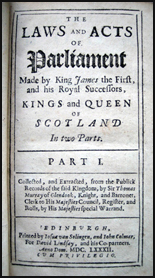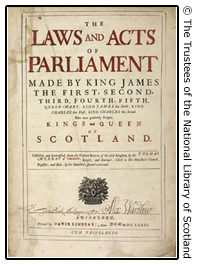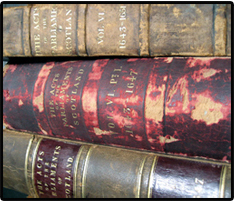Chronological Tables of Statutes, 1424 to 1707
The following tables contain a chronological list of the statutes of the Scottish parliament from 1424 to the union of 1707. In order to facilitate the transition to RPS, the traditional legal citation of each statute used in courts of law and by practising lawyers (according to the two editions already in use) is provided, along with the standard short title and the reference number and link to the equivalent text in the online edition
Jump to a specific reign using the links below:
Click here to download the entire list as a PDF Document (Requires Adobe PDF Reader).
Dating conventions
Statutes have traditionally been cited according to old style dates (where, prior to 1600, the new year began on 25 March). Thus the acts passed in the session that began on 19 January 1450 (as per modern usage) are dated 1449. In the tables that follow, where applicable, the old style date is cited first, followed by the new style date in brackets. It should be noted that reference numbers in RPS are based on new style dates. The dating used for each session is based on the day on which the parliament first began.
Editions of statutes cited

Title page from Glendook's
duodecimo edition (1682)
A large variety of collections of Scots statutes, both official and unofficial, have been published, beginning with the first collection of Black Acts (so named for its heavy letter type) printed under exclusive royal licence in 1541. Traditional legal citations of acts, however, conventionally refer to one of two authoritative editions. The first, commonly cited as the ‘duodecimo edition’, is that produced by Sir Thomas Murray of Glendook (modern-day Glendoick, Perthshire), lord clerk register from 1677 to 1681. His Laws and Acts of Parliament made by King James the First and his royal successors, kings and queens of Scotland was published in two duodecimo volumes in 1682 and contain the statutes from 1424 to 1681. To complete the collection up to the date of union, a third duodecimo volume of official sessional publications from 1685 to 1707 is usually found in company with Glendook’s edition (see, for example, the collected Scots Acts held in the National Library of Scotland, shelf-mark BCL.B5170). The second version of statutes, usually cited as the ‘record edition’, is that monumental achievement of Thomas Thomson and Cosmo Innes, The Acts of the Parliaments of Scotland, printed in twelve folio volumes from 1814-75. Published at command of the sovereign, this edition sought to print all surviving records of the pre-1707 Scottish parliament, private as well as public.

Title page from Glendook's
Folio edition (1681)
As both editions described above are still commonly in use, the following list gives citations for them both, along with the corresponding RPS reference number and link. The fact that Glendook’s edition is still so commonly cited is a surprise given its many deficiencies. As Cosmo Innes noted in his introduction to the first volume of APS, Glendook’s version seems to have implicitly copied from Sir John Skene’s collection of acts from 1424 to 1597 - The lawes and actes of Parliament, maid be King James the First and his successours kings of Scotland, visied and extracted furth of the register (Edinburgh, 1597) - and then from subsequent sessional publications, despite claiming to be based on a study of the original records. Skene’s edition was itself copied from earlier printed editions of the Black Acts and the original manuscripts seem to have been rarely consulted. Moreover, of the two Glendook editions published, it is the 1681 folio rather than the 1682 duodecimo edition that is the least afflicted with the typographical errors carried over from Skene’s edition, yet this edition is not preferred.

Volumes from the Record Edition (APS)
Glendook’s edition is also incomplete, frequently excluding public acts and occasionally entire sessions of parliament, yet including matters such as acts of sederunt as if they were statutes. Such omissions are largely addressed by the record edition, but APS too has its shortcomings. Separate but related acts are often merged into one, despite the original manuscript showing no basis for this (see, for example, APS ii 12, c.23 and RPS, 1427/3/7-16). The numbering of statutes is erratic from volume to volume, occasionally including forfeitures and other private business, in other instances leaving such acts out altogether. Original manuscript numbering is ignored completely. A particularly Victorian obsession with order and tidiness is evident in Thomson’s editorial practices, especially relating to the period between 1424 and 1460 where eleven manuscripts and one printed edition survive, none more authoritative or reliable than the next. Thomson’s reliance on a 1566 printed source for the acts of this period, improving on this by picking and choosing corrections from earlier manuscripts, means that the version printed by APS is of a text never in existence. At his worst, in an attempt to fill holes in fragmentary manuscripts or make awkward text fit, it has been shown that Thomson was not averse to inventing entire phrases and sentences if he considered this improved on a deficient source (see detailed discussion on this issue in Notes on the Sources for the Parliaments of Scotland, 1426-1466).
Statute titles
Standard succinct and descriptive titles for pre-1707 acts are given in the Chronological Table of the Statutes (2 vols, TSO, published annually) and it is these cited here. It should be noted that some short titles are misleading and should be used with care. Note, for example, the 1555 statute entitled ‘Chickens’ (RPS, A1555/6/33). The original manuscript makes no mention of domestic fowl, referring instead to wild game birds.
Pre-1707 statutes still in force
As of October 2017 there are 83 Acts of Parliament of Scotland (the pre-1707 Scottish parliament) still in force, either wholly, partly or as revised and amended by subsequent legislation. This total includes six Acts which are affected by repeals yet to take commencement. Statutes still in force at the time of writing are highlighted in blue within the chronological lists. An appendix separately listing these acts can be found here.